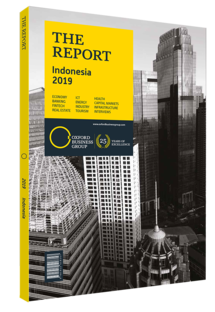Palapa ring project to boost ICT development in Indonesia
In an effort to bridge the geographical divide in digital services and provide high-speed internet across the country, the Widodo administration began work in 2016 on the Palapa Ring project. The priority infrastructure project comprises a 35,000-km fibre-optic cable network intended to provide access to 4G services throughout the archipelago by 2019. Some 34 provinces and more than 500 regencies will benefit from the project, especially those where it has not been viable for telcoms operators to lay cables, and increased connectivity should promote development within and between the country’s outlying islands.
The $1.3bn project is funded primarily by loans from state institutions, including Indonesia Infrastructure Finance and state-owned finance company Sarana Multi Infrastruktur Of the project’s three sections, the west and central portions have already been completed, while the administration is hoping to complete the eastern section by the middle of 2019.
Regional Disparities
Availing access to the internet outside of Java – the country’s most densely populated island and the location of the five cities with the fastest internet access – has been a slow and expensive process. The Palapa Ring encircles seven of the archipelago’s island groupings – Sumatra, Java, Kalimantan, Nusa Tenggara, Sulawesi, Maluku and Papua – and incorporates eight connecting networks. The government claims that its full operationalisation in 2019 will push broadband penetration into the double digits – up from 7.9% in June 2018 – and provide affordable 3G access every village, with its deployment most affecting connectivity in Nusa Tenggara and Papua.
The construction of the central section was completed in December 2018, and the first speed test was conducted the following month, when the minister of communications and IT successfully made a video call from a remote village in North Maluku to the minister of villages, who was in Jakarta. The central ring can reportedly facilitate speeds of up to 100 GB per second.
The government is seeking to launch a high throughput (HTS) satellite in 2022 that would complement the ring by connecting an additional 145,000 remote locations in eastern Indonesia. The private telco PT Pasifik Satelit Nusantara announced its own plans to launch the Nusantara Satu satellite in February 2019, which would become the first HTS system to be used over Indonesia and could expand access to 4G services to as many as 25m people in remote regions.
Knock-on Benefits
The multiplier effects of the Palapa Ring could significantly impact wide swathes of Indonesia’s economy. For instance, providing universal internet access in schools could increase digital literacy and, eventually, close the skills gap that has challenged the development of the ICT sector.
The government also envisions the project’s completion to pave the way for developing smarter cities, launching new start-ups and encouraging household entrepreneurs, which should contribute to achieving the target of a digital economy worth $100bn by 2025. It will allow existing digital businesses and their international competitors to serve more customers and create new income streams for myriad service vendors.
Greater connectivity will also encourage the adoption of new services in the burgeoning financial technology market and increase banking penetration in a market where around 51% of people remain unbanked. Connectivity in outlying regions should also create opportunities to deploy e-health services and remote diagnostics as part of efforts to improve public health outcomes. Lastly, greater access should also help to better local governance by facilitating the digitalisation of public services and bureaucratic procedures.
The project is fundamentally a means for addressing inequality across the archipelago. “This will unite us in the future,” President Joko Widodo told local media at the project’s launch in 2016. “Connectivity is not only about ports and toll roads. This is also about an information highway that is necessary for our future.”
You have reached the limit of premium articles you can view for free.
Choose from the options below to purchase print or digital editions of our Reports. You can also purchase a website subscription giving you unlimited access to all of our Reports online for 12 months.
If you have already purchased this Report or have a website subscription, please login to continue.

